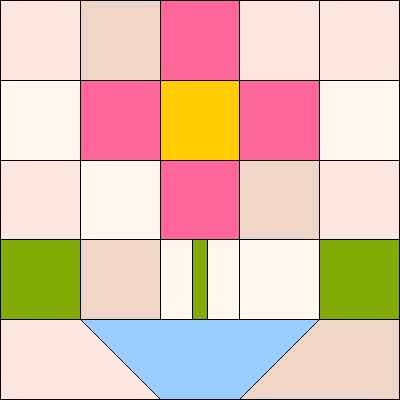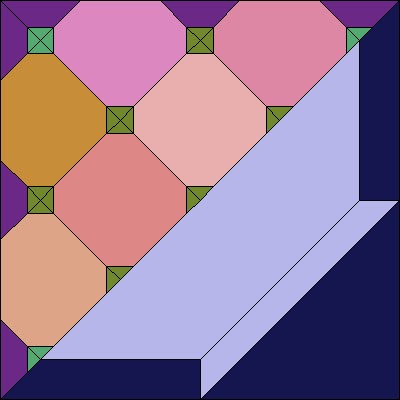Roseville pottery's Mostique pattern
features a variation of the abstracted rose
known as the Glasgow Rose or the Mackinstosh Rose.
Book designer Elbert Hubbard used an abstracted floral
on the cover of his inspirational pamphlet.
As modern designers pushed floral design to simpler abstractions, commercial quilt pattern designers (a rather new profession) experimented with floral abstractions, beginning in the teens and going through the 1940s.
BlockBase #774
Rosebud from Needlecraft magazine in July, 1929
Piecing lent itself to abstraction. In the eternal design circle artists who looked to antique quilts for abstraction ideas then created more abstracted designs for women looking for modern quilts.
Here are a few from newspapers and pattern catalogs of the era, exported from my PC program BlockBase. I found most of them in categories Realistic>Flowers and Realistic >Baskets. In BlockBase you can find the pattern and print it out any size by using the number in the Search by Number box in the task bar at the top.
BlockBase #752.5
Flower Pot Quilt
from Aunt Martha Studios
Placing a bowl or basket under a very abstract floral establishes its identity.
BlockBase #751.5
Primrose Patch from Workbasket magazine
in 1945
BlockBase ##723
Basket of Flowers, possibly from Comfort magazine
BlockBase #758
Garden of Friendship from the
Alice Brooks/Laura Wheeler syndicated column in the 1930s
The designers who worked under the Brooks/Wheeler pen names brought in new shapes in the 1930s.
BlockBase #752
Leafy Basket
Another from the Alice Brooks/Laura Wheeler syndicated column in the 1930s.
The problem with these designs is that they were not really what the seamstresses of the era wanted. One comes across very few quilts ever made in these pieced modern patterns.
BlockBase # 783
Pansy from Ruby Short McKim
The seamstresses of the 1910-1950 era just didn't seem to be ready for the designs.
But by 1981 people like Mary Jenkins in Wales were ready. See her version of McKim's Pansy here at Little Welsh Quilts:











I can think of some reasons why these designs didn't catch on with quiltmakers;-) 1 -- many odd shaped pieces per block requiring templates, 2. -- many small pieces per block to sew together and jadvanced sewing techniques required ( set in seams, curved seams, maybe hand sewing or applique); 3 -- all that work for what payoff? How good can these really look made up? I certainly can't tell from the pattern. Just saying what would go thru my head if I were looking for something to make. . . .
ReplyDelete